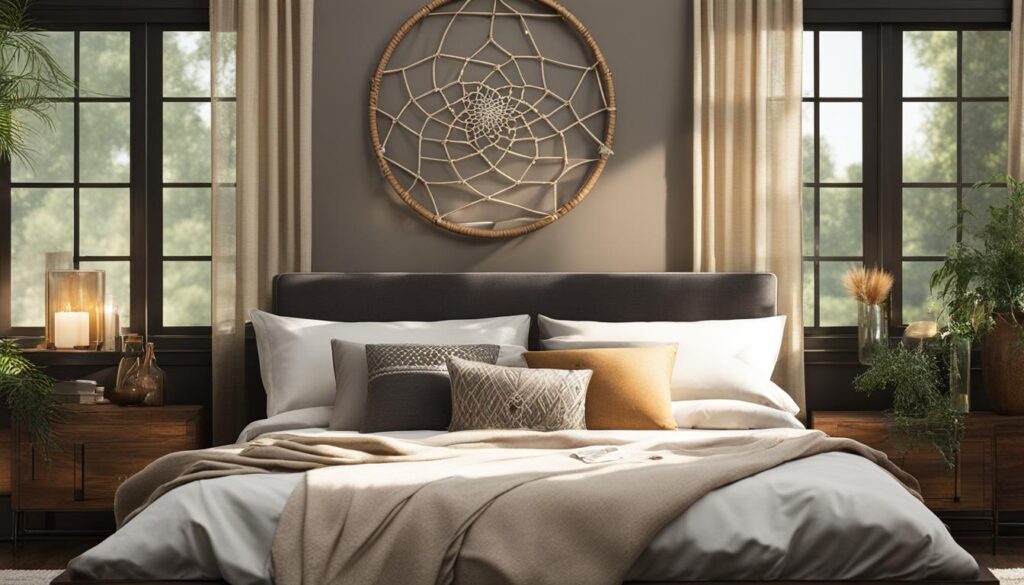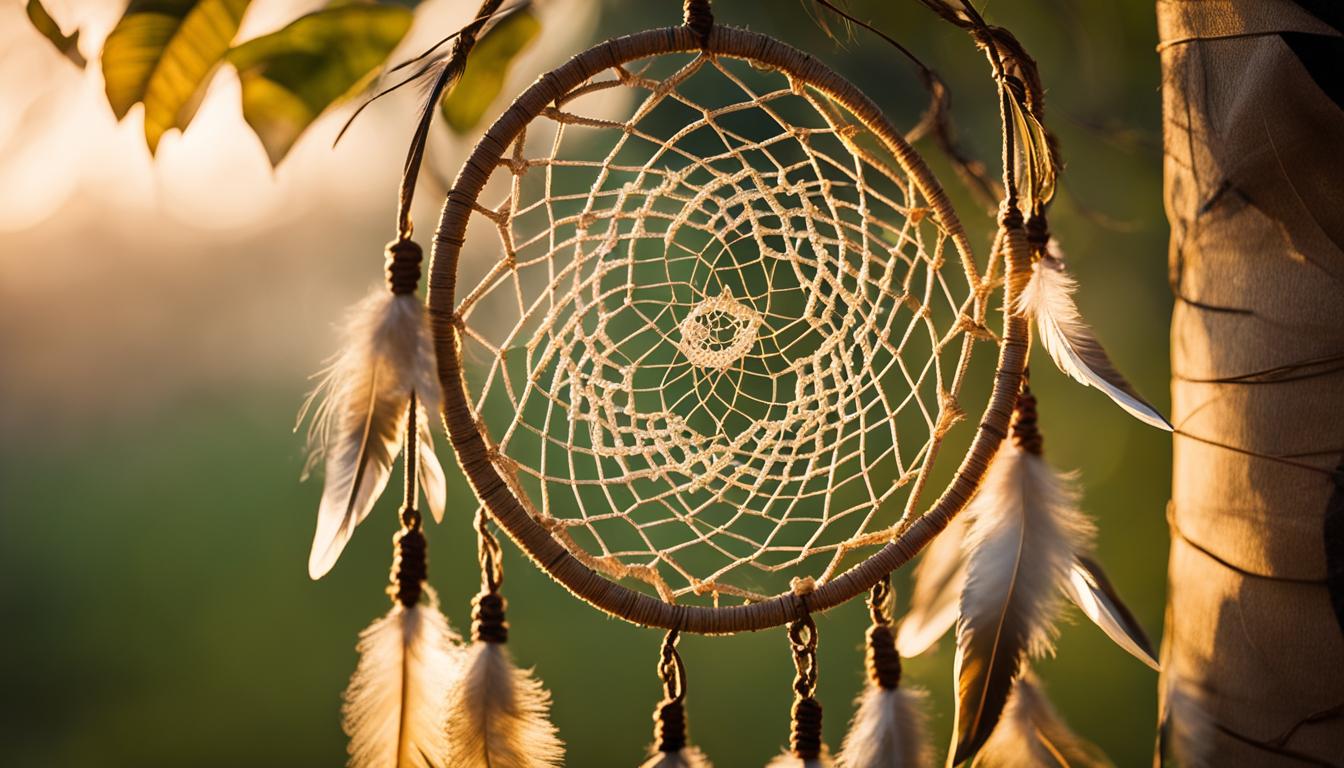Dream catchers have long intrigued people with their mystical allure and captivating beauty. These handmade willow hoops, intricately woven into a web or net, are often adorned with feathers and beads, creating a mesmerizing display. But beyond their aesthetic appeal, dream catchers hold deep cultural and spiritual significance, particularly in Native American tribes.
To truly understand the meaning of dream catchers, we must delve into their fascinating history and symbolism. From their origins with the Ojibwe people to their adoption by various tribes and cultures, dream catchers have served as powerful symbols of protection, filtering out negative dreams, and allowing only the positive ones to pass through.
Key Takeaways
- The round shape of dream catchers represents the earth’s physical form.
- The intricate web woven within dream catchers filters and captures bad dreams while allowing good dreams to pass through.
- Feathers attached to dream catchers act as ladders for positive dreams to descend upon the sleeper.
- Dream catchers hold cultural significance in various indigenous cultures, particularly Native American tribes.
- Modern uses of dream catchers include using them as symbols of hope and healing.
The History and Origin of Dream Catchers
Dream catchers have a rich history that dates back to the Ojibwe people, who used them for protection and to ward off bad dreams. The Ojibwe believed that a spider woman, known as Asibaikaashi, would weave her magical webs using willow hoops and sinew to catch any negative dreams or harm that could come to infants while they slept. This legend forms the core of the dream catcher’s origin, and it has been passed down through generations.
Asibaikaashi’s magical webs quickly gained popularity among other Native American tribes through intermarriage and trade. The dream catcher’s unique design and purpose resonated with other tribes, leading to its widespread adoption. It became especially popular during the Pan-Indian movement of the 1960s and 1970s, which sought to unite Native American tribes and cultures.
“The dream catcher originated with the Ojibwe people and quickly spread to other tribes and cultures through intermarriage and trade.”
The traditional dream catcher consists of a willow hoop woven with a web-like pattern and adorned with feathers and beads. The round shape of the dream catcher symbolizes the earth, while the web is believed to filter out bad dreams, allowing only positive dreams to pass through. Feathers attached to the dream catcher act as ladders for good dreams, which descend onto the sleeper. This symbolism, along with the cultural significance attached to dream catchers, continues to be cherished by Native American communities and beyond.
The Spread of Dream Catchers
The adoption of dream catchers by other tribes and cultures beyond the Ojibwe is a testament to the profound impact of their symbolism and purpose. Native American dream catchers are now recognized worldwide for their cultural significance and beauty. They serve as a reminder of the interconnectedness of different tribes and their shared spiritual beliefs.
To understand the history and origin of dream catchers, it is important to acknowledge their roots with the Ojibwe people. Their legends and traditions continue to shape the symbolism and purpose of dream catchers, making them a cherished part of Native American culture.
The Meaning and Symbolism of Dream Catchers
Dream catchers hold multiple meanings tied to the physical world. They are not only beautiful decorations, but they also carry deep symbolism. Understanding the meaning behind dream catchers can help us appreciate their significance in different cultures. Here, we will explore the symbolism, interpretation, and significance of dream catchers.
Symbolism of Dream Catchers
The round shape of dream catchers symbolizes the earth’s physical shape. It represents the interconnectedness of all things and the cycle of life. The web woven within the hoop serves as a filter, capturing negative dreams and allowing positive ones to pass through. It is believed that the web traps the bad dreams and dissipates them with the morning light, while the feathers attached to the dream catcher act as a ladder for good dreams to descend onto the sleeper.
In various indigenous cultures, dream catchers are seen as a symbol of protection and safety. They are believed to ward off negative energy and bring positive vibes to the sleeping individual. Dream catchers also serve as a cultural symbol, representing Native American identity and spirituality.
The Significance of Dream Catchers in Different Cultures
Dream catchers are deeply rooted in Native American culture and have significant cultural and spiritual importance. In addition to the Ojibwe people who originated dream catchers, other Native American tribes have adopted them as symbols of protection and spirituality. Each tribe may have their own interpretation and variations of design, incorporating unique symbols and materials.
Beyond Native American culture, dream catchers have gained popularity worldwide. They are often seen as symbols of hope, healing, and positive energy. Many people use dream catchers as decorative items in their homes or wear them as accessories to embody the spirit of protection and connection to the spiritual realm.
| Symbolism | Interpretation | Significance |
|---|---|---|
| Round shape | Represents the earth’s physical shape and interconnectedness | Symbolizes unity and the cycle of life |
| Web | Captures negative dreams and dissipates them with daylight | Brings protection and filters out negativity |
| Feathers | Act as a ladder for good dreams to descend onto the sleeper | Symbolize positivity and connection to the spiritual realm |
| Native American Identity | Represents Native American culture, spirituality, and protection | Carries cultural significance and heritage |
Despite the widespread popularity of dream catchers, there are concerns about cultural appropriation and the commercialization of their symbolism. It is important to respect the cultural significance and origins of dream catchers while appreciating their beauty and symbolism.
Next, we will explore the modern uses of dream catchers and their cultural significance in today’s society.
Dream Catchers in Modern Society
In modern society, dream catchers have become more than just traditional Native American symbols. They have transcended their cultural roots and found new meaning and significance in various contexts. Dream catchers have been embraced by individuals and communities as symbols of hope, healing, and unity.
One notable example of dream catchers’ modern use is their role in providing comfort and support to communities affected by tragedy, such as school shootings. The Little Thunderbirds Drum and Dance Troupe from the Red Lake Indian Reservation has traveled to these communities, sharing songs, stories, and gifting dream catchers as a symbol of unity and healing. These dream catchers serve as reminders of resilience, strength, and the power of collective support.
However, it is essential to note that along with their increased popularity, there has also been a rise in the mass production of imitation dream catchers that lack the cultural significance and authenticity of traditional ones. These mass-produced dream catchers often use cheap materials and do not carry the same spiritual and cultural value.
Table: Comparing Traditional and Mass-Produced Dream Catchers
| Aspect | Traditional Dream Catchers | Mass-Produced Dream Catchers |
|---|---|---|
| Materials | Natural materials like willow hoops and sinew | Cheap materials and synthetic fibers |
| Construction | Handmade with intricate weaving techniques | Machine-produced with less attention to detail |
| Cultural Significance | Symbolic connection to Native American traditions and beliefs | Lack of cultural context and authenticity |
| Value | Considered sacred and valued as spiritual artifacts | Primarily seen as decorative items |
As dream catchers continue to hold cultural significance, it is crucial to respect their origins and cultural context. Choosing authentic, handmade dream catchers made by Native American artisans ensures the preservation of their cultural heritage and supports communities that rely on these crafts for their livelihood. By doing so, we can appreciate the beauty and symbolism of dream catchers while honoring their cultural and spiritual significance.

Conclusion
Dream catchers hold a deep cultural and spiritual significance in Native American tribes. They originated with the Ojibwe people and have spread to other tribes and cultures through intermarriage and trade.
Dream catchers symbolize protection, the filtering of negative dreams, and the descent of positive dreams. They are believed to ward off nightmares and allow only pleasant dreams to pass through. The round shape of dream catchers represents the earth’s physical form, while the intricate web inside captures bad dreams and releases them during the day.
While dream catchers have gained popularity in modern society as symbols of hope and healing, there are concerns about the loss of authenticity and cultural appropriation. It is important to respect the cultural significance and origins of dream catchers while appreciating their beauty and symbolism. By understanding and preserving their history and meaning, we can honor the traditions of Native American tribes and ensure that dream catchers continue to be valued for their spiritual significance.
FAQ
What is the meaning of dream catchers?
Dream catchers are handmade willow hoops woven into a web or net, often adorned with feathers and beads. They hold significant symbolism in Native American tribes, serving as a form of protection and armor. They are believed to filter and capture bad dreams while allowing good dreams to pass through.
What is the history and origin of dream catchers?
Dream catchers originated with the Ojibwe people and spread to other tribes and cultures through intermarriage and trade. The legend of the Spider Woman, Asibaikaashi, who wove webs to protect Ojibwe infants, is at the core of the dream catcher’s origin.
What is the meaning and symbolism of dream catchers?
The round shape of dream catchers represents the earth’s spherical character, and the web filters and captures bad dreams while allowing good dreams to pass through. Feathers attached to dream catchers act as ladders for good dreams to descend onto the sleeper. They are also seen as a symbol of oneness among indigenous cultures and tribes, representing Native American identity.
What are the modern uses of dream catchers?
In modern society, dream catchers have been used as symbols of hope and healing. They have been given to communities affected by tragedies such as school shootings as a symbol of unity and comfort.
Are there concerns about the commercialization and mass production of dream catchers?
Yes, the commercialization and mass production of dream catchers have led to concerns about the loss of authenticity and cultural appropriation. Mass-produced dream catchers often lack the cultural significance and authenticity of traditional ones.




